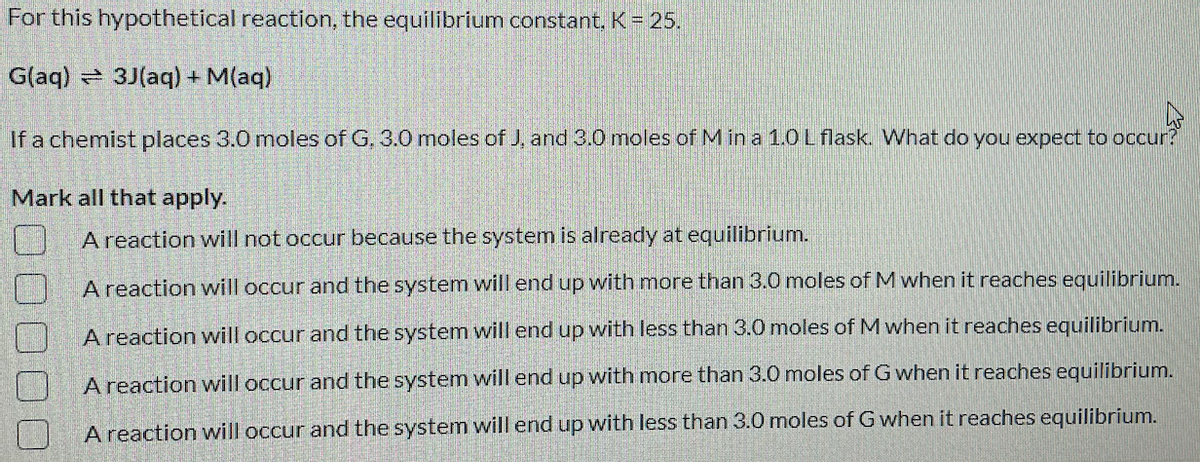For this hypothetical reaction, the equilibrium constant, K = 25. G(aq) = 3J(aq) + M(aq) If a chemist places 3.0 moles of G, 3.0 moles of J, and 3.0 moles of M in a 1.0 L flask. What do you expect to occur?
For this hypothetical reaction, the equilibrium constant, K = 25. G(aq) = 3J(aq) + M(aq) If a chemist places 3.0 moles of G, 3.0 moles of J, and 3.0 moles of M in a 1.0 L flask. What do you expect to occur?
Chemistry: The Molecular Science
5th Edition
ISBN:9781285199047
Author:John W. Moore, Conrad L. Stanitski
Publisher:John W. Moore, Conrad L. Stanitski
Chapter12: Chemical Equilibrium
Section: Chapter Questions
Problem 61QRT
Related questions
Question

Transcribed Image Text:For this hypothetical reaction, the equilibrium constant. K= 25.
G(aq) 3J(aq) + M(aq)
If a chemist places 3.0 moles of G, 3.0 moles of J, and 3.0 moles of M in a 1.0L flask. What do you expect to occur?
Mark all that apply.
A reaction will not occur because the system is already at equilibrium.
A reaction will occur and the system will end up with more than 3.0 moles of M when it reaches equilibrium.
A reaction will occur and the system will end up with less than 3.0 moles of M when it reaches equilibrium.
A reaction will occur and the system will end up with more than 3.0 moles of G when it reaches equilibrium.
A reaction will occur and the system will end up with less than 3.0 moles of G when it reaches equilibrium.
Expert Solution
This question has been solved!
Explore an expertly crafted, step-by-step solution for a thorough understanding of key concepts.
Step by step
Solved in 2 steps

Knowledge Booster
Learn more about
Need a deep-dive on the concept behind this application? Look no further. Learn more about this topic, chemistry and related others by exploring similar questions and additional content below.Recommended textbooks for you

Chemistry: The Molecular Science
Chemistry
ISBN:
9781285199047
Author:
John W. Moore, Conrad L. Stanitski
Publisher:
Cengage Learning

Chemistry & Chemical Reactivity
Chemistry
ISBN:
9781133949640
Author:
John C. Kotz, Paul M. Treichel, John Townsend, David Treichel
Publisher:
Cengage Learning

Chemistry & Chemical Reactivity
Chemistry
ISBN:
9781337399074
Author:
John C. Kotz, Paul M. Treichel, John Townsend, David Treichel
Publisher:
Cengage Learning

Chemistry: The Molecular Science
Chemistry
ISBN:
9781285199047
Author:
John W. Moore, Conrad L. Stanitski
Publisher:
Cengage Learning

Chemistry & Chemical Reactivity
Chemistry
ISBN:
9781133949640
Author:
John C. Kotz, Paul M. Treichel, John Townsend, David Treichel
Publisher:
Cengage Learning

Chemistry & Chemical Reactivity
Chemistry
ISBN:
9781337399074
Author:
John C. Kotz, Paul M. Treichel, John Townsend, David Treichel
Publisher:
Cengage Learning

Chemistry: An Atoms First Approach
Chemistry
ISBN:
9781305079243
Author:
Steven S. Zumdahl, Susan A. Zumdahl
Publisher:
Cengage Learning

Chemistry for Engineering Students
Chemistry
ISBN:
9781337398909
Author:
Lawrence S. Brown, Tom Holme
Publisher:
Cengage Learning
